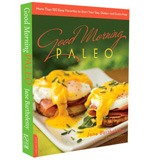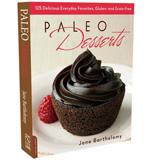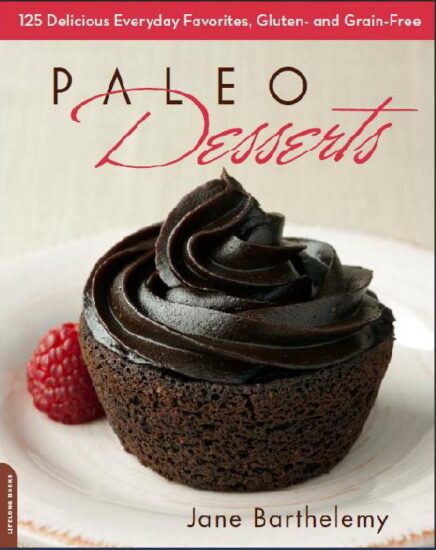Paleo Desserts is the first comprehensive dessert cookbook for the wildly popular Paleolithic diet, featuring 125 gluten and grain-free, non-dairy, natural low-carb & no-refined-sugar versions of favorite classic recipes, from Chocolate Cake to Apple Pie. The recipes feature coconut in many forms, and natural zero-glycemic sweeteners.
Now you can have your cake and be Paleo, too! The modern Paleolithic diet and lifestyle – based on eating hunter-gatherer foods that our ancestors thrived on, for optimal health, energy, and weight loss-has surged in popularity. But with grains, dairy, and refined sugars off the menu, indulging isn’t always easy.
Order your copy now at Independent Booksellers, Amazon, Barnes & Noble, or Powell’s Books.
Chapter 1 – Introduction
“Eat food. Not too much. Mostly plants.”
Michael Pollan, author of In Defense of Food: An Eater’s Manifesto
I have a confession to make. The book you’re holding in your hands is here for one reason and one reason only—my enormous passion for sweets. A passion so strong, I had to find a way to create sweets that are also good for my body. As a chef, health practitioner, and ex-sugar-holic, I discovered that I had just the right combination of excitement, knowledge, and tools to invent a collection of original Paleo recipes for my favorite desserts. I hope they’ll soon be yours, too.
Sneaking sweets is not an option for me. For my body, refined foods and sugars are toxic. In many people, the reaction to poor-quality food is delayed. They feel crummy after a few months, and a true disease or metabolic dysfunction doesn’t appear until months or years later. However, in my body, the response is immediate. My eyes glaze over; I become lethargic, moody, and experience a brain fog. I can’t remember what I was doing last and I can’t focus my mind. I must then drink copious amounts of pure water and exercise, until eventually the haze passes. Although my condition has no name, I’d like to think my body recognizes what is real food and what is not.
After twenty years of a low-carb diet—all the while still craving sweets—I decided to do something about it. Instead of running away or avoiding my desires, I decided to turn and face them. I dove into them with a passion, and this book is the result. Imagine my surprise when I had no reaction to these sweets. What a discovery! After eating them I felt balanced and happy. I had been so deprived of simple sweets, I wanted to celebrate! This journey is part of my healing process and I’m so thrilled to be able to share it with you.
The Paleo diet was first brought into the spotlight by Loren Cordain, PhD, considered the world’s leading expert on the Paleolithic diet, and author of the best-selling The Paleo Diet: Lose Weight and Get Healthy by Eating the Food You Were Designed to Eat. Dr. Cordain’s extensive research focused on the evolutionary and anthropological basis for dietary health and the links between modern diets and disease.
What did our ancestors really eat? Dr. Cordain studied human diets during the Paleolithic period spanning 2.5 million years, gleaning evidence from microscopic scratches and wear patterns on teeth. According to Dr. Cordain, our ancestors were omnivores, eating a hunt-and-gather diet of fresh wild fruits, vegetables, and animals, depending upon the climate in which they lived. The major difference between their diet and our modern diet is the development of agriculture about ten thousand years ago, which brought us grains and legumes (beans). More recent changes to grain cultivation and refining methods came about around 1890 with the advent of refined flour. In the last sixty years, the introduction of industrial farming methods, preservatives, chemicals, and longer shelf lives has brought major changes to our tables. With a global food industry narrowly focused on volume at the expense of nutritional value and environmental balance, it is no surprise that chronic health problems are increasing worldwide.
Our ancestors were physically strong, fit, and active. They had to walk miles to gather food, migrate to distant areas, and outrun wild animals. Just two hundred years ago, Lewis and Clark crossed the American Pacific Northwest wilderness on foot with a company of soldiers, walking as far as 50 to 75 miles per day. Do you know anyone who could do that today?
Dr. Cordain’s view that our modern diet is inadequate to sustain good health is supported by Dr. Weston Price, a renowned nutritionist and dentist. He traveled the world, studying indigenous peoples, and his findings clearly demonstrate the strong connection between diet and health. Wherever he went, he found that native people living on a traditional diet had very low rates of dental decay and sickness, whereas the same genetic groups eating a modern Western diet had higher rates of tooth decay and disease. His fascinating accounts are documented in the book Nutrition and Physical Degeneration.
Instead of grains, these recipes use coconut. Pure unrefined coconut is delicious, nutritious, and easy to digest. It is free of chemicals and antinutrients. That’s why many people find the Paleo diet a perfect solution to living gluten-free. We can enjoy our favorite foods with no deprivation. We can have chocolate cupcakes and ice-cream sandwiches without guilt or discomfort.
The recipes in this book follow the strict guidelines developed by Dr. Cordain. They use no refined foods or high-carb sweeteners—no grains, coconut flour, coconut sugar, stevia, agave nectar, or even honey—with a zero or low impact on your blood sugar.
If you’re on a special diet and feel deprived, this book can be a true companion. Paleo Desserts are compatible with many alternative diets. Besides being Paleo, gluten-free, and celiac-friendly, all these recipes are vegetarian, meaning they contain no meat. All recipes in this book are free of the common allergens: dairy, corn, potatoes, peanuts, and soy. They are all diabetic-friendly. In this book you will find 63 vegan recipes, such as Key Lime Pie. There are 67 tree nut-free recipes, and 35 desserts that are 100 % percent raw food, such as Chocolate Fudge Easy Chocolate Mousse. And the good news is they’re all made with fresh, whole-food ingredients, which I find even more delicious than their refined counterparts.
If you thought you had to give up sweets on the Paleo Diet, think again. In this book I offer you a full collection of favorite traditional desserts that conform 100 % to the Paleo diet, with a zero or low impact on your blood sugar. Rather than thinking about what you’re eliminating, just take a look at the tremendous assortment of nutritious fruits, vegetables, roots, nuts, and seeds that are available for you. These are all the best ingredients—straight from Nature. And you’ll see—it is truly amazing, the huge variety of easy, luscious desserts you can enjoy using just these ingredients. In fact, my guests can’t tell the difference. Whether it’s pumpkin pie or chocolate cake, people love Paleo desserts and come back for more.
Paleo Desserts are for everyone. When we remove refined and inflammatory foods from our diet, we reduce the risk of chronic diseases such as diabetes, arthritis, obesity, heart disease, and cancer. Most people on the Paleo Diet report that they lose weight and experience higher energy levels. They feel younger and enjoy life more fully. If you’re in good health and want to keep it that way, Paleo desserts can allow you to enjoy sweets that are both delicious and nourishing. The high quality, nutrient-dense foods in these recipes – plus no refined ingredients – will help maintain and increase your vitality.
Many of us crave sweets. This has a direct impact on our eating habits and our health. What do the ancient medical systems of the world say about food cravings? Chinese medicine, one of the oldest known systems, recognizes five flavors that the body needs to be in balance: sweet, spicy, salty, sour, and bitter. Our ancestors understood that it’s important to have a bit of each flavor at every meal.
Which of these five flavors do you crave most? Craving signals a need or an imbalance in the body. If you’ve cut out all the sweet tastes from your diet, such as dairy, grains, and legumes, then it’s understandable you might feel a desire for sweets. Chinese medicine also observes that a diet high in refined sugar accelerates ageing in the body. The role of this book is to help you to feel young and achieve a balance of flavors by enjoying natural sweets that do not raise blood sugar levels or cause an insulin response. In the recipes that follow, you’ll find a host of delicious recipes aimed at stabilizing your metabolism for optimum health.
When we eat—what happens? We first sense the texture—is it crunchy or smooth? Then the taste informs our mouth and sense of smell, telling us if what we’re eating is sweet, or bitter, or chocolate. Then we swallow, and this is the real litmus test for me. How does it feel in my body? Is it a yes? A maybe? Or a definite no? What I call real food—food made with pure, natural ingredients—is delicious all the way down into the body. And these desserts are real food. After all, the underlying reason to eat good food is to enjoy health. Knowing that you can have sweets on the Paleo diet is great news. Real food promotes health on all levels—body, mind, and spirit. Eating real food shows respect for your body, and allows you to live in harmony with planet Earth. And who doesn’t want that?
In our modern society, refined carbs are cheap and readily available. In fact, many people have become dependent on them instead of on real foods, at the expense of our health.
We love sweets. We sneak them, we break our diets for them, and we feel guilty about it. Whenever we even think about desserts, we feel a combination of joy and shame. Many of us simply cut them completely from our diet. Others overindulge. What if delicious desserts were low carb and made of nourishing, healthy food? That’s what you get here with these Paleo desserts.
Let’s look at the following numbers. Conventional desserts are made of high-carb flours and high-carb sweeteners. White flour is the most common, with 73 % carbs. Whole wheat, rice, and coconut flour are not much better – they’re all very high in carbs. By contrast, these delicious Paleo desserts are made with low-carb shredded coconut, with only 27 % carbs. Shredded coconut has about one-third the carbs of white flour. This huge difference in Paleo desserts can impact your health in a positive way.
Paleo Desserts are Low in Carbohydrates
% Carbs
Almond Flour 21%
Shredded unsweetened coconut 27%
Whole wheat flour 67%
Coconut flour 71%
White flour 73%
Brown rice flour 78%
The sweeteners that I use are an even bigger surprise. Compare the common sweeteners in the following chart. Most conventional sweeteners are high in carbs. However, the natural Paleo sweeteners used in these recipes have zero carbs.
Sweeteners Carbohydrate Comparison
% Carbs Net Impact
*Just Like Sugar, Table Top 0%
*Organic Zero Erythritol 0%
*Yacon Syrup, Raw 55%
High Fructose Corn Syrup 79%
Agave Nectar 79 – 95%
Honey, Raw, unprocessed 82%
Maple Syrup 85 – 93%
Coconut Sugar / Nectar 92%
Cane Sugar 100%
* The top three sweeteners on the chart are the ones I use in my recipes. In addition to having zero carbs and zero calories, these all-natural sweeteners are delicious. They blend and enhance the authentic flavors in every recipe from chocolate brownies to pumpkin pie. After testing hundreds of sweeteners, these top are the only ones I can wholeheartedly recommend. They offer delicious, sweet results, excellent texture, convenient measuring, and minimum blood sugar or insulin response in the body.
So go on, forget the guilt of desserts. Instead, delight in the flavors, textures, and colors of these beautiful and nutritious low-carb Paleo sweets. Are you ready to get started?
About the Author:
Jane Barthelemy has served as Dessert Chef, Head Chef, and CFO of various restaurants and bakeries around the country. She writes and teaches seminars on gluten-free & Paleo food, and runs her own private healing practice, Quantum Body Healing.
Order your copy of Paleo Desserts at Independent Booksellers, Amazon, Barnes & Noble, or Powell’s Books.





No Replies to "Preview my book, Paleo Desserts"